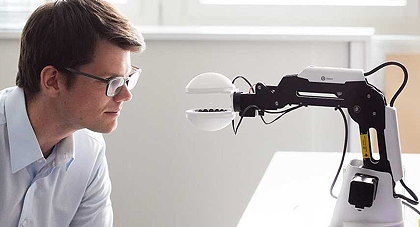Although soft, rubber-like grippers are available, they are easily contaminated and do not provide good positioning accuracy.
Another drawback of conventional grippers is that a different gripper is needed for almost every new shape of object that they need to handle. A single ultrasonic gripper, operating on a principle known as “acoustic levitation”, can handle objects of different shapes and sizes. And because it could position a tiny object precisely, it could be used on the end of a robot arm that was not itself particularly precise.
Schuck’s prototype device consists of a pair of hemispherical shells lined on their inside with lots of tiny loudspeakers. Using software to control the ultrasonic waves produced by the speakers, pressure points are created that can trap tiny objects and suspend them so that they appear to float in the air.

Marcel Schuck with his acoustic gripper that can suspend fragile objects without touching them. Photo: ETH Zurich / Stefan Weiss
Schuck wants to use part of a 150,000 Swiss franc ($155,000) fellowship grant to create a development kit for potential users. If he can demonstrate that his ideas can work practically in the real world, he might start up a business next year to commercialise the technology.

